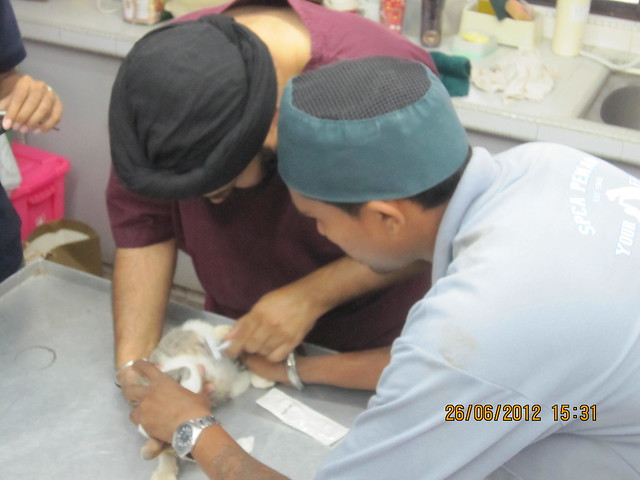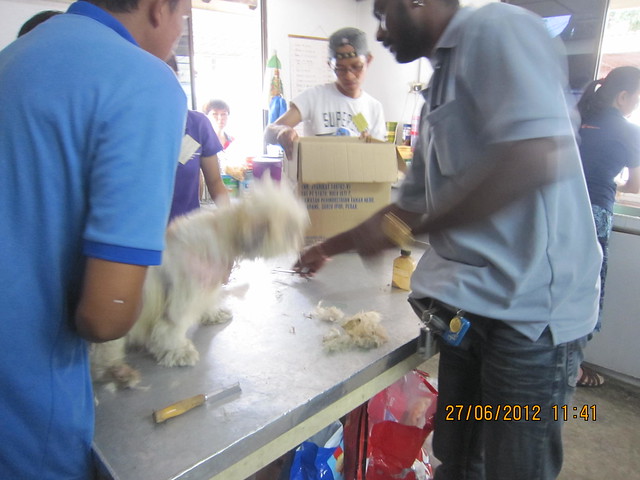The diarrhea by the pups today wasn't as intense as it was, so we had more time for SOCIALIZING!!!!
By socializing we mean bringing the dogs and pups out from their kennels and allow them to run around, play with us, get some good sunshine in the SPCA's compound. However, the lady volunteer who came that day gave us a tip.
You see, normally I play with my bitches at home by letting them hopping on me, and pretty much everyone else who come into the house. And they aren't exactly the large type, probably below 10kg so for them to pound on me or anyone else more than 12 is still fine.
However, we want the dogs here to be adopted. By allowing these dogs to get used to hopping on people would induce their likelihood to do it on their new hosts, and worse on their children. This is when the people complain that the dogs are being "delinquents" and uncontrollable. Hence, our role is to make sure the dogs are already disciplined even before the future owners adopt the dogs, so that the dogs' adopted chances are so much greater because the less problem they will be.
But of course, I personally thinks that disciplining the dogs ourselves are much more of a fun.
After lunch, its Doctor's Visit!!! He's a vet of course. Apparently he took up after his father, who came on the Friday itself, same goes to his brother. Dang, a house full of vets, and they are all guys. This house gotta have love for the animals! Anyway, he's quite cool.
Though he and his dad stressed a lot on this:
"Vets are legally allowed to treat humans. Medical doctors however, never will be able to treat animals."
But it wasn't a statement for us to show our arrogance, it was to allow us to have pride on our profession so we do not feel inferior to any other professions out there.
So basically the vet came in to heck on the animals who are on the list of review, or having conditions which we or the staffs of SPCA find out. The common conditions are always skin related, diarrhea, fungal infection or fever. The chances of the animals to attain traumas are minimal, and the animals here are still so young hence abnormal growths are close to 0% possibility. Some antibiotics and assessments were given and done, and the rest of the visit was just conversations between the Dr and us.
Pre-Clinical Skills:(to be mastered before vets enter clinical years)
1- Handling, which includes scruffng of cats,restraining of dogs, communicating with the animals so as they do not feel threatened or be in distress as minimally during consultations. If the animals do not feel comfortable or feel threatened, the chances of them to be aggressive while being hostile is high, hence putting the handlers in danger.
2-Medication, which is to know how to identify the common meds used for the animals. Antibiotics such as clavamox, betamox, amoxylin; antihistamine such as chrolopreharmine; diarrhea treatments such as charcoal. The formula and dosages are to be monitored so as the animals do not suffer repercussions and side effects. Skin problems are to be tackled orally and topically, normally anti-histamines are given, together with Dermaprep, potassium permanganate and sulphuramide to rid the fungal or bacterial infections.
3-Vital Signs, which is to be able to attain the TPRs, Temperature, Pulse rate and Respiration rate from the animals. The best way to attain temperature is by putting the thermometer into the anus and tilt in towards one side so that the stub touches the opposite rectal wall. The stub used for the anal temperature reading is smaller than the ones used in oral temperature reading. Thermometer should be wet or gelled before insertion so that the animals do not feel too uncomfortable as it is. The tails should be kept down, as erected them will cause distress and fear to the animals handled. Pulse rate can be palpated 2 ways, one is via the heart, in which both dogs and cats can be read by putting our finger on the area which the bent left forelimb reaches. Another way would be putting the finger under the tongue and feel the pulse, if the animals actually allow.
Dermatitis(skin infection) and Euthanasia:
Dermatitis can be very dangerous, especially in SPCA where the animals are being confined into an enclosed area, due to its infectious nature. Once the dermatitis doesn't cure after 6 weeks of treatment, its considered chronic and the animal infected needs to be put to sleep. The reason being, a) the human in contact will become carriers of the infecting agent, whereas b)allowing the animal to become the host increases the risk of further outbreak of the similar dermatitis to the other residing animals.
Types: A and B
A- Fungal or bacteria. If worsen, mange might grow caused by mites.
Pathology: Due to the animal's weak immunity against the infection
Signs: Parallel lined fur loss
B- Ring worms
Pathology: Weak immunity against ring worm infection
Signs: Circular fur loss that cause lesions.
Treatment for both:
Antihistamines. antibiotic, medicinal baths using tac tic.
When chronic dermatitis is confirmed after 6 weeks, euthanasia is performed in SPCA via IntraVenously. Barbiturate is injected via the cephalic vein, kidney, or direct into the heart.
One of the dogs we had have to be put to sleep due to the dermatitis infection. Barbiturate works in minute, once injected, it was only 2 minutes before the dog just collapsed and stop breathing. Sad as it is, it is a vet's job to decide when and where, if the situation is feasible for euthanasia to be performed.
Not so much of a "saving life" now is it?
Apart from vet day, Tuesday is also a grooming day!
But since its SPCA, grooming practically meant bathing the dogs. Most just do on the normal shampoo, some needs to be on Tac-Tic so as the dermatitis can lay down. And the abang working there gave me a small tip on cleaning the dogs' anal area. Before we proceed, we needs to hold onto the anal region and squeeze own the remains of the glandular area so as the discharge wouldn't store and burst,maggots wouldn't be able to grow and get nasty.
As for cat, I didn't had chance to bath them, but we did de-flea them.
Defleaing cats only take 5 minutes. There are 3 different methods, 3 different products and efficiency.
A-Frontline Spray, where one wold only need to spray on the cat and thoroughly massage the liquid over.
B-Spot on cream, which is pretty much very specific on the cat's body.
C- Advantix tablet, and by feeding the cat and cure the flea internally, though this method is much more expensive compared to the other 2 methods.
Somewhere near where we had our dinner. We wanted to head for steamboat so that Big Sis can give us a treat, but the place was closed down on Tuesday. So I shall make a review about it on the next post!



not an easy feat to be a vet =)
ReplyDeletesame goes to every profession out there. you've gotta have passion for what you do
Deleteyeah true enough..the passion have to be really high especially in a place where ur profession is been looked down....if not, I might have go somewhere else by now..haha
Deletehaha true enough! one's gotta love it to own it!
Delete